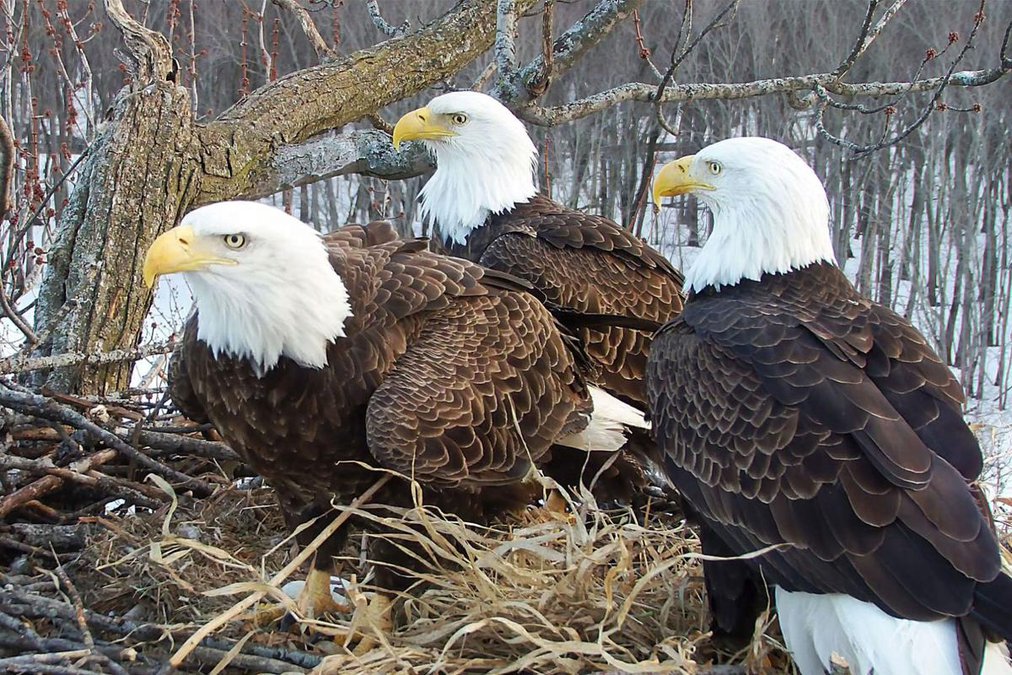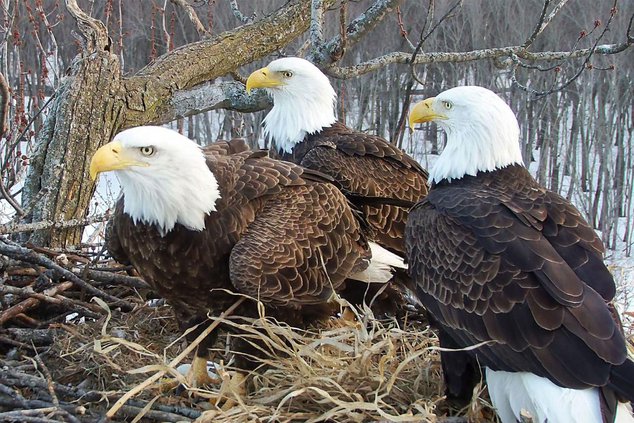NEWPORT NEWS, Va. (AP) — When it comes to the Chesapeake Bay, the majestic bald eagle has come back from the dead.
Driven from historic nesting strongholds like the James River by pesticides in the 1970s, the national bird has become a success story.
“We are just in an amazing time right now,” said Bryan Watts, co-founder and director of the Center for Conservation Biology at the College of William and Mary. “We’re sort of in the golden age of fish-eating waterbirds for the bay.”
Not just bald eagles, but fish-eaters like osprey and blue heron also once died out on the James. Today, they’ve swelled to numbers Watts believes are well above what even Capt. John Smith encountered on the cusp of the 17th century.
“In terms of eagles,” said Watts, “we are protecting them. We’re not shooting them like we did in the late 1800s and early 1900s. We don’t consider them competitors for muskrats or for fish, and so we’re not killing them.”
As a result, in an annual survey this spring, Watts and his recovery team found more than 300 nesting pairs on the James, and estimate there are more than 3,000 in the greater bay.
That total is 10 times the initial goal of 300 pairs for the bay set by Virginia, Maryland and Delaware when recovery efforts began back in 1977.
The deadliest human threat to bald eagles wasn’t bullets, but chemicals.
The widely used pesticide DDT decimated eagles and other waterbirds starting in the 1950s.
Then the James suffered a second blow when the insecticide Kepone was illegally dumped in the river in the ‘60s and ‘70s. In 1972, DDT was banned in the U.S. but the damage was already done: In 1975 and for the next five years, no breeding pairs were left on the James.
Then, in 1980, a single pair was spotted building a nest on the river.
Ten years later, there were 18 nesting pairs. And 10 years after that, in 2000, there were 57.
Last year, Watts’ survey crew found 289 nesting pairs on the James. This year, 302.
He and others credit the recovery to bans on DDT and Kepone and to improved management: The federal Endangered Species Act of 1973 protected eagles and their breeding and foraging sites.
“It’s a great success story in terms of the history of our country,” Watts said. “We were seeing these species disappear and we made a conscious decision as a society that we didn’t want that to happen.”
Biologist Mitchell Byrd has been tracking bald eagles in Virginia since the Chesapeake Bay Bald Eagle Recovery Team was appointed by the U.S. Fish and Wildlife Service in 1977.
Every spring, Byrd, who turns 91 next month, crams into a tiny Cessna four-seater with Watts and retired fighter pilot Canton Alexander “Capt. Fuzzzo” Shermer.
In the beginning, they flew the state’s entire coastal plain, swooping down to tree canopy level to count each nest. Since 2016, however, they only survey the James.
“We don’t need to follow the population in terms of whether it’s recovering — that’s pretty obvious,” Byrd said. “It’s these other basic biological events that we’re more interested in now.”
They conduct two surveys — the first in late February and early March before leaves sprout to conceal the nests, and the second in late April to count eggs and chicks.
As the eagle population explodes, what the researchers are finding is pretty much what they expect: more infighting among the birds as they battle for territory, and a lower reproductive rate — or fewer eggs and chicks per nest — as competition increases for resources.
Has the eagle population peaked on the James?
“We don’t know whether we’ve reached that point,” Byrd said. “But we think we either have or are awfully close to it.”
Maryland ceased surveying bald eagles in 2004 when the entire state hit nearly 400 breeding pairs.
“Once the eagle nesting population had essentially met full recovery goals, we decided to discontinue that for other higher priorities,” said Glenn Therres, associate director of the Wildlife and Heritage Service at the Maryland Department of Natural Resources.
Bald eagles were removed from the endangered species list a decade ago. Today’s eagle abundance is evidence that the bay has plenty of fish to feed them, and the birds are able to adapt to a changing and developing landscape.
“Nesting pairs are nesting in places that we wouldn’t even have dreamed of 30 years ago,” Therres said — places like cellphone towers, major power plants and backyards.
“There’s a nesting pair or two, as I understand it, in the District of Columbia that’s raised young,” said Therres. “You can’t get a heckuva lot more developed than the District of Columbia.
For Watts and Byrd, though, recovery isn’t the end of the story — there are still lessons to learn.
“This is one of the more important data sets on population recovery on the planet, and we want to continue that data set,” said Watts. “We have been surveying eagles here on the James since the late 1950s, and so we want to see how the story ends.”
___
Information from: Daily Press, http://www.dailypress.com/




